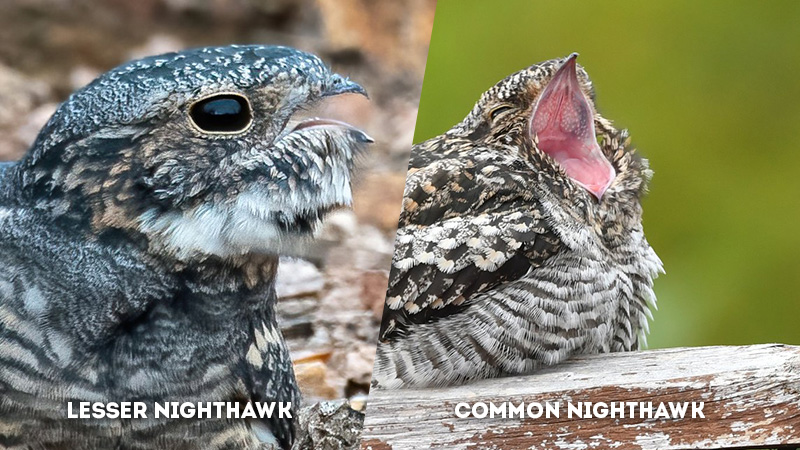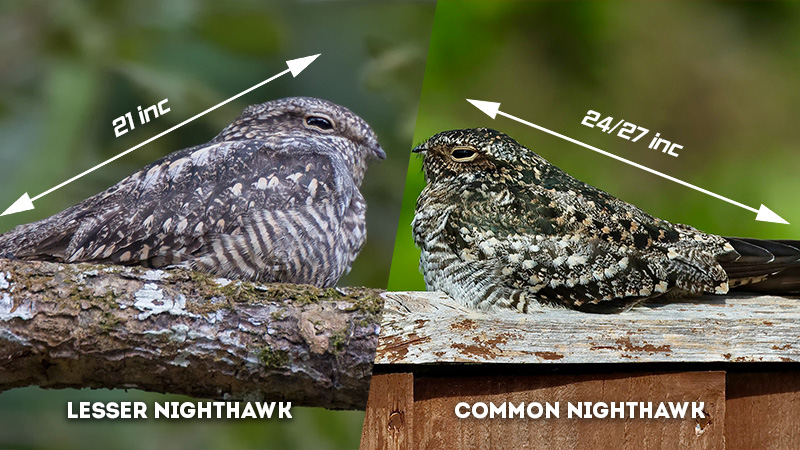In the realm of avian diversity, the lesser nighthawk and common nighthawk emerge as intriguing subjects of study.
These nocturnal birds, belonging to the nightjar family, possess captivating characteristics that set them apart while weaving connections between their behaviors, habitats, and distinct calls.
From their nocturnal insectivore tendencies to the intricacies of their courtship displays, these nighthawks reveal the delicate balance between adaptation and specialization.
Exploring their differences in vocalizations, sizes, preferred habitats, and geographic ranges sheds light on their unique roles within the intricate tapestry of the natural world.

Key Differences Between Lesser Nighthawk and Common Nighthawk
Wingspan
- Lesser Nighthawk: With an approximate wingspan of 21 inches, the lesser nighthawk boasts a relatively compact wingspan. This smaller wingspan is adapted to its preferred open habitats, enabling agile aerial foraging for insects during the night.
- Common Nighthawk: In contrast, the common nighthawk exhibits a larger wingspan, ranging from around 24 to 27 inches. This expanded wingspan suits its behavior of dusk and dawn insect hunting, covering a broader area during its feeding flights.
Vocalizations

- Lesser Nighthawk: The lesser nighthawk’s vocalizations are characterized by a low toad-like trill. This unique sound has been described as challenging to locate, adding an element of mystery to the bird’s presence.
The subdued trill is well-suited for its secretive nature, making it less conspicuous as it navigates its nocturnal surroundings. - Common Nighthawk: Conversely, the common nighthawk is known for its distinctive “peent” call. This vocalization is an integral part of its courtship display, often emitted during evening flights.
The repeated “peent” sound is more pronounced and serves as a communication tool during its active twilight hours, especially during the breeding season.
Habitat
- Lesser Nighthawk: The lesser nighthawk is typically found in open habitats such as deserts, grasslands, and scrublands.
Its chosen habitats align with its aerial foraging behavior, where its smaller wingspan of approximately 21 inches aids in swift maneuverability. These open landscapes provide ample space for the nighthawk to hunt insects on the wing. - Common Nighthawk: The common nighthawk showcases a more versatile habitat preference, often seen in urban areas, grasslands, and even forested regions.
This adaptability stems from its larger wingspan, spanning between 24 to 27 inches. This broader wingspan allows it to cover larger distances during its dusk and dawn feeding flights, making it well-suited for varied environments.
Behavior
- Lesser Nighthawk: The lesser nighthawk’s behavior revolves around its nocturnal habits. It engages in aerial foraging during the night, darting through the skies to capture insects mid-flight. Its trill-like vocalizations add to its elusive character, aiding it in locating prey without drawing unnecessary attention.
- Common Nighthawk: The common Nighthawk is recognized for its captivating courtship display. During the evening, males execute elaborate aerial maneuvers, accompanied by their “booming” sound, formed by the air rushing through their wing feathers. This display serves the dual purpose of attracting mates and showcasing their prowess in the skies.
Distribution
- Lesser Nighthawk: The lesser nighthawk’s distribution spans both North and South America, as it undertakes Neotropical migrations. This migration pattern emphasizes its connection to various regions within the Americas, making it a truly transcontinental species.
- Common Nighthawk: Similarly, the common nighthawk displays a migratory lifestyle across the Americas. Its range extends from northern Canada to parts of South America, covering a substantial portion of the hemisphere. This extensive distribution highlights its adaptability to various climates and habitats.
Migration
- Lesser Nighthawk: The lesser nighthawk, a Neotropical migrant, embarks on remarkable journeys between its breeding and wintering grounds across the Americas. This migratory behavior underscores its connectivity between South and North America, allowing it to traverse diverse landscapes and climates.
- Common Nighthawk: Much like its lesser counterpart, the common nighthawk exhibits migratory tendencies across the Americas.
From the northern reaches of Canada to the southern stretches of South America, its migratory path covers expansive territories, emphasizing its adaptability to varying environments.
Size

- Lesser Nighthawk: Measuring approximately 21 inches in wingspan, the lesser nighthawk boasts a more modest size among its nighthawk peers. This smaller stature aligns with its agility in open spaces, facilitating precise aerial foraging as it hunts insects under the cover of darkness.
- Common Nighthawk: Contrastingly, the common nighthawk stands out with a larger wingspan ranging from 24 to 27 inches.
This extended wingspan complements its unique feeding behavior and allows for effective insect hunting during the twilight hours. The larger size contributes to its capacity for covering broader distances in pursuit of prey.
Preferred Open Habitats
- Lesser Nighthawk: The lesser nighthawk is well-adapted to open habitats such as deserts, grasslands, and scrublands. These expansive landscapes provide ideal hunting grounds for its nocturnal insect forays.
Its smaller wingspan and nimble flight enable it to navigate these open areas adeptly, seeking out insects on the wing. - Common Nighthawk: While the common Nighthawk also frequents open environments like grasslands, it showcases a wider habitat range that includes urban areas and even forested regions.
Its larger wingspan affords it greater versatility, enabling it to thrive in various settings and capitalize on the diverse insect populations each offers.
Courtship Display
- Lesser Nighthawk: The courtship display of the lesser nighthawk is often less conspicuous compared to its counterpart. Its trill-like vocalizations and less elaborate aerial performances still serve the purpose of attracting mates and establishing connections within its preferred habitats.
- Common Nighthawk: The common Nighthawk’s courtship display is a captivating spectacle. Males engage in elaborate aerial acrobatics accompanied by their unique “booming” sound—a result of air rushing through their wing feathers. This grand display serves both the purpose of courtship and the demonstration of their prowess in the skies.
Breeding Grounds
- Lesser Nighthawk: Breeding grounds for the lesser nighthawk are scattered across the Americas, from the southern regions of South America to the northern reaches of North America.
These varied locales reflect its role as a Neotropical migrant, adapting to different ecosystems as it travels. - Common Nighthawk: The common nighthawk’s breeding grounds span from northern Canada to the southern reaches of South America. This extensive range underscores its adaptability to an array of climates, further emphasizing its ability to thrive in diverse environments.
Nocturnal Behavior
- Lesser Nighthawk: The lesser nighthawk is characterized by its exclusively nocturnal behavior. It becomes active under the cover of darkness, utilizing its cryptic plumage and low toad-like trill to remain inconspicuous as it engages in aerial foraging for insects throughout the night.
- Common Nighthawk: Similarly, the common nighthawk is also a creature of the night. Its nocturnal nature is evident in its behavior of dusk and dawn activity. This behavior is accentuated by its distinct “peent” call during courtship displays, showcasing its engagement with the twilight hours.
Feeding Behavior
- Lesser Nighthawk: The lesser nighthawk employs an aerial feeding strategy to capture insects mid-flight. Its agile flight, coupled with its smaller wingspan, enables precise maneuvers as it hunts insects in open spaces, reflecting its adaptation to its preferred habitats.
- Common Nighthawk: The common nighthawk’s feeding behavior centers around its dusk and dawn insect hunting flights. With its larger wingspan, it covers more ground during its feeding excursions, allowing it to intercept insects on the wing with efficiency.
Physical Appearance
- Lesser Nighthawk: The lesser nighthawk is distinguishable by its relatively smaller size, sporting a wingspan of approximately 21 inches.
Its muted colors and compact form contribute to its inconspicuous presence in open landscapes, where it employs stealth and agility in its hunting endeavors. - Common Nighthawk: With a larger wingspan ranging from 24 to 27 inches, the common Nighthawk commands a more imposing physical presence.
Its broad wings and distinctive white wing patches make it recognizable during flight. This larger size accommodates its feeding behavior and contributes to its overall adaptability.
Preferred Habitat
- Lesser Nighthawk: The lesser nighthawk thrives in open habitats such as deserts, grasslands, and scrublands. These expanses provide ample space for its nimble flight as it navigates these environments in pursuit of insect prey.
- Common Nighthawk: The common nighthawk’s preferred habitat extends beyond open areas to encompass urban environments, grasslands, and even forested regions. Its larger wingspan and adaptability allow it to exploit diverse habitats for feeding and nesting.
Vocalization Type
- Lesser Nighthawk: The lesser nighthawk’s vocalizations consist of a low toad-like trill. This sound is evocative of its secretive nature, aiding its ability to communicate while remaining unobtrusive within its chosen habitats.
- Common Nighthawk: The common nighthawk’s vocalization is the iconic “peent” call. This sound, especially prominent during courtship displays, serves both as a mating signal and a representation of its connection to the twilight hours.
Nocturnal Insectivore
- Lesser Nighthawk: The lesser nighthawk, a true nocturnal insectivore, has adapted its behavior to the cover of night. With precise aerial foraging, it captures insects on the wing under the veil of darkness. This unique feeding strategy enables it to exploit the abundance of nocturnal insects while avoiding daytime predators.
- Common Nighthawk: Likewise, the common nighthawk is also a skilled nocturnal insectivore. Its dusk and dawn feeding habits align with the peak activity of crepuscular insects.
This behavior involves capturing insects during the transitional phases between day and night, ensuring a steady supply of sustenance.
Size of Wingspan
- Lesser Nighthawk: Sporting a wingspan of approximately 21 inches, the lesser nighthawk boasts a smaller wingspan. This compact size supports its swift and agile flight as it navigates its chosen open habitats.
The smaller wingspan contributes to its ability to perform intricate aerial maneuvers during its nocturnal insect hunts. - Common Nighthawk: In contrast, the common nighthawk displays a larger wingspan, ranging from about 24 to 27 inches. This extended wingspan accommodates its dusk and dawn insect-hunting flights. It enables the bird to cover more ground during these active periods, enhancing its efficiency in capturing flying insects.
Location Naming History
- Lesser Nighthawk: The name “nighthawk” first emerged in England as a local term for the European nightjar. However, the term “lesser nighthawk” itself does not contribute significantly to naming history.
Instead, the species is distinguished by its scientific name (Chordeiles acutipennis), which reflects its genus and species characteristics. - Common Nighthawk: The term “nighthawk” has historical roots in England as a local name for the European nightjar. Interestingly, the common nighthawk’s name aligns with this historical context.
The common nighthawk, scientifically known as Chordeiles minor, shares this nomenclature connection with its nocturnal relative, the nightjar.
Size Comparison
- Lesser Nighthawk: With its smaller size, the lesser nighthawk is a diminutive presence among nighthawk species. This size is suited to its agile and stealthy flight, allowing it to maneuver through its preferred open landscapes with ease.
- Common Nighthawk: Contrasting the smaller size of its counterpart, the common nighthawk displays a more substantial stature. Its larger wingspan and more robust build enhance its performance during both hunting and courtship displays.
Geographic Range
- Lesser Nighthawk: The lesser nighthawk’s geographic range spans across the Americas, encompassing both North and South America.
Its Neotropical migration pattern highlights its transcontinental journey between breeding and wintering grounds, connecting various regions within the Americas. - Common Nighthawk: The common nighthawk’s extensive geographic range covers an even broader expanse of the Americas.
From the northern reaches of Canada to the southern landscapes of South America, its migratory path highlights its adaptability to a wide array of climates and habitats.
Lesser Nighthawk Vs Common Nighthawk: Comparison Table
| Aspect | Lesser Nighthawk | Common Nighthawk |
|---|---|---|
| Wingspan | Approximately 21 inches | Larger, around 24-27 inches |
| Vocalizations | Low toad-like trill | Distinctive “peent” call |
| Habitat | Deserts, grasslands, scrublands | Urban areas, grasslands, forests |
| Behavior | Aerial insect foraging at night | Feeding at dusk and dawn |
| Distribution | Neotropical migrant | Migratory across Americas |
| Migration | Seasonal migrations | Seasonal migrations |
| Size | Smaller | Larger |
| Preferred Open Habitats | Yes | Yes |
| Courtship Display | Possibly less pronounced | Display flights with “booming” |
| Breeding Grounds | South and North America | Northern Canada to South America |
| Nocturnal Behavior | Yes | Yes |
| Feeding Behavior | Aerial insect hunting | Insect hunting during dusk/dawn |
| Physical Appearance | Slightly smaller | Relatively larger |
| Preferred Habitat | Open areas | Varied habitats |
| Vocalization Type | Trill | “Peent” call during display |
| Nocturnal Insectivore | Yes | Yes |
| Size of Wingspan | Smaller | Larger |
| Location Naming History | Not connected to “nighthawk” term | Connected to “nighthawk” term |
| Size Comparison | Smaller | Larger |
| Geographic Range | South and North America | North Canada to South America |
Frequently Asked Questions
The vocalizations serve different purposes for each species. The lesser nighthawk’s low trill helps it remain discreet while locating prey. The common nighthawk’s “peent” call aids in courtship and territorial displays, fostering social bonds and establishing dominance.
The common nighthawk’s elaborate aerial displays and “booming” calls attract mates and demonstrate fitness. In contrast, the lesser nighthawk’s more subtle courtship behavior relies on other cues, possibly favoring less conspicuous interactions.
The lesser nighthawk’s smaller wingspan suits its open habitats, allowing agile insect capture. The common nighthawk’s broader wingspan enables wider coverage, facilitating effective hunting in diverse environments from grasslands to urban areas.
Both species play a vital ecological role as nocturnal insectivores. They help regulate insect populations, contributing to ecosystem balance by controlling numbers of insects like moths and other nocturnal pests.
The term “nighthawk” originally referred to the European nightjar. While the lesser nighthawk’s name isn’t deeply connected to this history, the common nighthawk’s name retains that link, reflecting its nocturnal habits similar to those of the nightjar.
To Recap
In the realm of avian diversity, the lesser nighthawk and common nighthawk emerge as intriguing subjects of study.
These nocturnal birds, belonging to the nightjar family, possess captivating characteristics that set them apart while weaving connections between their behaviors, habitats, and distinct calls.
From their nocturnal insectivore tendencies to the intricacies of their courtship displays, these nighthawks reveal the delicate balance between adaptation and specialization.
Exploring their differences in vocalizations, sizes, preferred habitats, and geographic ranges sheds light on their unique roles within the intricate tapestry of the natural world.